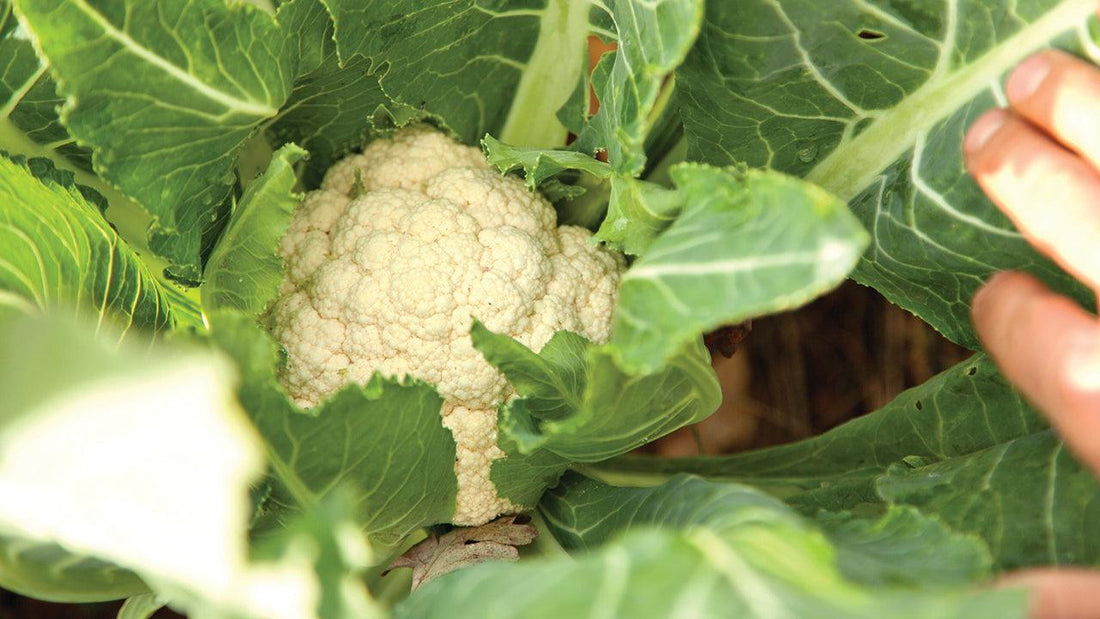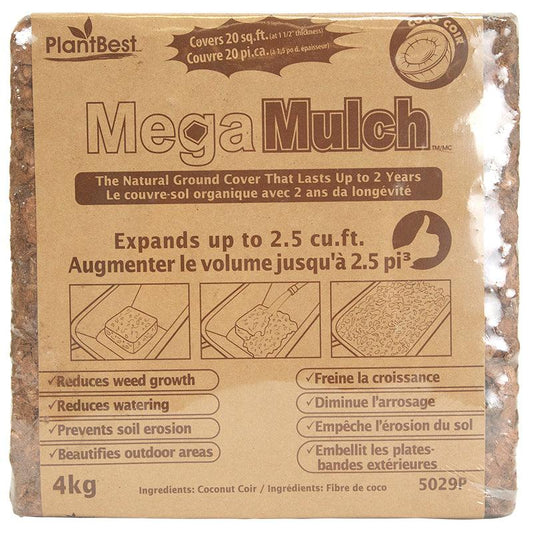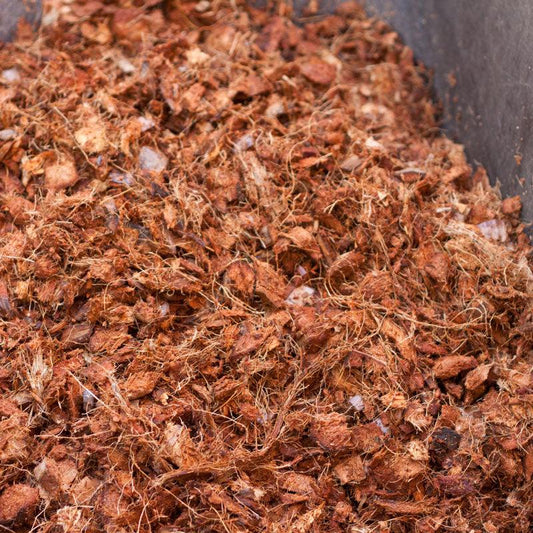Cauliflower, a relative of broccoli and cabbage, is a challenging plant to grow in the garden. Start seeds in the garden in July-August for a fall crop or in the spring for a mid-summer harvest. Cauliflower is sensitive to any interruption in uniform growth such as cold soil or air temperatures, lack of fertility, inconsistent watering, pest or disease pressure or poor root growth. Small heads or premature head development can result from plant stress. Plant cauliflower varieties that will grow well for your planting time or growing zone.
If you're wondering when, exactly, is a good time to plant your cauliflower seeds, enter your last frost date (for spring planting) and first frost date (for fall planting) into our Seed Planting Calculator. It will calculate the best dates to direct seed or start seeds indoors.
You can also calculate when to plant your seeds by using the sowing information on the back of the seed pack and counting backwards from your last frost date on your calendar.

Cauliflower Types
Cheddar: Orange heads similar to the traditional white variety, but higher in nutritional value. Good flavor. Add a pop of color to your meal; coloration becomes brighter when cooked. About 60 days to harvest. Hybrid.
Flowering (Fioretto, Karifurore): White flowering heads on stems that do not form a ball head. Both the stem and flowers are consumed and are sweeter than traditional forms. 70 days to harvest. Hybrid.
Purple: Large purple heads that change to green when cooked. Purple cauliflower has the highest disease resistance. It has a sweeter flavor tending towards broccoli. About 200 days to harvest. It is best to plant purple cauliflower in July-August for a spring harvest. Heirloom.
Romanesco: A cross with a broccoli variety forming a vivid light green spiraled head. Prized for its delicate, nutty flavor. Romanesco is best planted in July-August for a fall harvest. 75–100 days to harvest. Heirloom.
Traditional (Snowball): The most common type of cauliflower grown. Firm, pure white heads with large protective leaves. Snowball is reliable strain that is heavy yielding. Delicate flavor. 52–70 days to harvest. Can be spring or late summer planted. Downy mildew resistant.
Growing Basics
Soil: Cauliflower prefers a soil pH between 6–7 and temperatures of 60–65°F for germination (will tolerate temperatures between 50–80°F) which drains well and has plenty of organic matter. Try growing cauliflower in some of our Peaceful Valley Organics Potting Soil; it is an excellent, organic all-around mix.
Air Temperatures: When growing cauliflower, the air temperature should be around 75°F and no lower then 25°F.
Seed Longevity: If properly stored, the seeds should be viable for about 4 years.
Yield: Varies widely depending on variety as well as weather and water availability. A rough estimate is around one to two pounds per plant.
Spacing: Cauliflower seeds should be planted 15–24” apart with rows spaced 24–36” apart.
Companion Planting:
- Incompatibility — Peas, strawberries, tomatoes.
- Companions — Radish, cucumber, chard, broccoli, beets, onions, sage, thyme.
Water Requirements: Water needs to be consistent and plentiful for head formation. Use mulch protect shallow root system from damage and to retain adequate moisture.
Planting & Growing

Cauliflower is a cool season crop and can be sown in spring or late summer (Romanesco is best to plant in the summer for a fall harvest).
Spring planting: Start indoors about 5 weeks prior to transplanting outdoors. Sow seed ¼–½” deep in a soilless seed starting mix (Quickroot). Keep seed bed consistently moist.
Summer Planting: Direct seed cauliflower in July–August. Sow seed ¼–½” deep and cover with loose soil or compost as not to hinder emergence. Keep soil moist and protect from pests with a light rowcover such as Agribon AG15. Romanesco (planted in July) will be ready to harvest in the fall, the purple variety will be ready to harvest the following spring (more cold tolerant plant). Snowball variety can be planted in August for a fall harvest.
Transplanting: Transplant out when seedlings have at least 4–6 true leaves and soil temperatures are 60°F (danger of frost has past if planting in the spring). Bury the plants to the first true leaf in well-drained soil and space plants about 18” apart and 25” between each row. Cauliflower needs uninterrupted growth, so provide consistent water, a balanced fertilizer and protection from pests and disease. Uneven watering can cause stress to the plant and lead to undersized heads. Drip irrigation should be used and no overhead watering (can lead to disease).
To get the white cauliflower curds (head), you can encourage blanching by gathering the outer leaves over the head and tie with a string or rubber band. Only do this to the white cauliflower varieties such as Snowball; colored varieties need sun to develop the full color.
Harvesting
Harvest cauliflower heads when they are tight. Heads reach 6–8” in diameter, but make sure to harvest before flowering. Cut stems, leaving a ruffle of leaves around head to help extend the quality and store in a refrigerator.
Common Pests & Diseases

Alternaria leaf spot: Spots with black to brown margins no lower leaves, which will progress to yellowing and leaf drop. Spores borne by soil and wind and equipment may spread. Use an organic fungicide labeled for Alternaria leaf spot.
Aphid: usually found on the underside of leaves or on flower head. Control by strong spray of water (our Bug Blaster Spray Nozzle works great), beneficial insects, or an organic insecticide labeled for aphids.
Blackleg: Appears as brown to yellow spots on leaves with graying centers. Caused by wet weather or overhead watering and spores. Use an organic fungicide labeled for blackleg.
Cabbage looper: Look for white moths near plants. Hand pick them off or use an organic insecticide labeled for cabbage loopers.
Clubroot: Causes wilted plants. Spreads below soil from other infected weeds or cabbage family members. Fungus creates exaggerated tap and secondary roots which infect soil with spores as they decay. Use an organic fungicide labeled for clubroot.
Flea Beetles: Visual symptoms are tiny holes in leaves. Use Agribon AG15 floating row covers or an organic insecticide labeled for flea beetles.
Root Maggot: Colonies form on underside of leaves. Spray with an organic insecticide labeled for root maggots.
Pest Control – IPM (Integrated Pest Management)
Integrated Pest Management (IPM) is an effective and environmentally sensitive approach to pest management that starts with the least invasive or impactful control methods and considers the use of chemical controls as the last step. For more information watch our Integrated Pest Management video.
Important to practice good cultural controls for pest management of cauliflower. Cultural controls such as removing plants after harvest (to avoid leaving food for insects to continue to multiply on), practice crop rotation (i.e. do not plant crops in same family, in the same area for 3 years), use row covers such as Agribon AG15 (apply before insects arrive or to protect against birds when plants are young).
Common Questions
How to create well formed white heads? The common Snowball varieties should be tied up using string or bands to cover head with the outer leaves. This will blanch the curd to a nice white color. Harvest may be as soon as one week thereafter in the summer months or up to one month in the cooler fall months. Colorful varieties should not be tied up.
Why do cauliflower heads splay out and not stay compact? This is commonly due to excess heat, sunlight or nitrogen, or the head is over mature.
Why don’t heads form on established plants? Cauliflower is the most finicky of the cabbage family. If temperatures are not suitable, the head formation will suffer or be non-existent. Hot or dry spells will hinder head formation (use heat tolerant varieties, but do not use for summer sowing). Hard freezes can damage heads that are already formed (select cold tolerant varieties and use only for summer sowing, such as purple). Inconsistent watering can also lead to poor curd formation. Maintain soil moisture by using drip irrigation and a layer of mulch.
How can the harvest season be extended? Plant several varieties since size and formation of heads will coincide or succession plant to stagger when plants mature.
Definitions
Heirloom: Heirloom seeds come from open-pollinated plants that pass on similar characteristics and traits from the parent plant to the next generation plant. Heirloom vegetables are old-time varieties generally which have been in production since before WWII, and have been saved and handed down through multiple generations.
Hybrid: a cross between two or more unrelated plant varieties. The two different varieties are cross bred, resulting in a seed that carries one or more favorable traits (increased yield, uniformity, color, disease resistance.) Hybrid seeds are not GMO, as they are manually cross-bred, not genetically modified in a lab. Hybrid seed is often sterile or does not reproduce true to the parent plant. Therefore, never save the seed from hybrids.
Open Pollinated: generally refers to seeds that will “breed true”. When the plants of an open-pollinated variety self-pollinate, or are pollinated by another representative of the same variety, the resulting seeds will produce plants roughly identical to their parents. Genetic traits may differ only slightly due to variations created by local conditions.
GMO: Genetically Modified Organisms were genetically modified in a laboratory where DNA genes are extracted and mixed with other unrelated plants to improve characteristics. Saved seed will not always be viable and may be trademarked to prevent unauthorized use.



